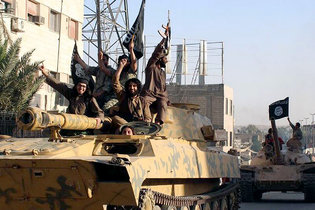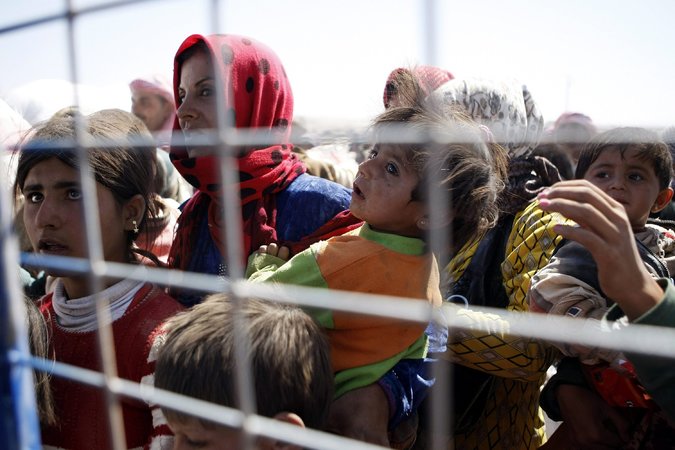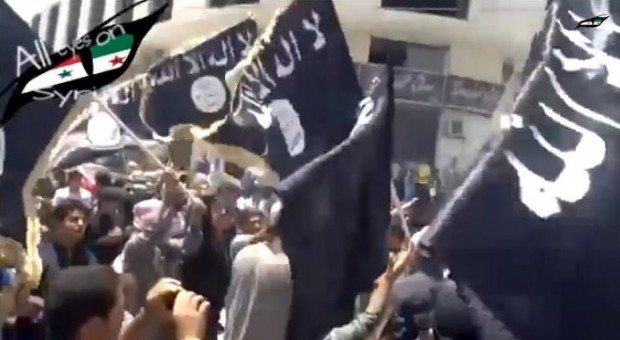WASHINGTON — The United States and allies launched airstrikes against Sunni militants in Syria early Tuesday, unleashing a torrent of cruise missiles and precision-guided bombs from the air and sea on the militants’ de facto capital of Raqqa and along the porous Iraq border.
American fighter jets and armed Predator and Reaper drones, flying alongside warplanes from several Arab allies, struck a broad array of targets in territory controlled by the militants, known as the Islamic State. American defense officials said the targets included weapons supplies, depots, barracks and buildings the militants use for command and control. Tomahawk cruise missiles were fired from United States Navy ships in the region.
The strikes are a major turning point in President Obama’s war against the Islamic State and open up a risky new stage of the American military campaign. Until now, the administration had bombed Islamic State targets only in Iraq, and had suggested it would be weeks if not months before the start of a bombing campaign against Islamic State targets in Syria.

Bahrain, Jordan, Qatar, Saudi Arabia and the United Arab Emirates took part in the strikes, American officials said, although the Arab governments were not expected to announce their participation until later Tuesday. The new coalition’s makeup is significant because the United States was able to recruit Sunni governments to take action against the Sunni militants of the Islamic State. The operation also unites the squabbling states of the Persian Gulf.
The strikes came less than two weeks after Mr. Obama announced in an address to the nation that he was authorizing an expansion of the military campaign against the Islamic State, also known as ISIS.
Unlike American strikes in Iraq over the past month, which have been small-bore bombings of mostly individual Islamic State targets — patrol boats and trucks — the salvo on Tuesday in Syria was the beginning of what was expected to be a sustained, hourslong bombardment at targets in the militant headquarters in Raqqa and on the border.
The strikes began after years of debate within the Obama administration about whether the United States should intervene militarily or should avoid another entanglement in a complex war in the Middle East. But the Islamic State controls a broad swath of land across both Iraq and Syria.
Defense officials said the goal of the air campaign was to deprive the Islamic State of the safe havens it enjoys in Syria. The administration’s ultimate goal, as set forth in the address Mr. Obama delivered on Sept. 10, is to recruit a global coalition to “degrade and ultimately destroy” the militants, even as Mr. Obama warned that “eradicating a cancer” like the Islamic State was a long-term challenge that would put some American troops at risk.
American warplanes had been conducting surveillance flights over Syria for more than a month in anticipation of airstrikes, but it had been unclear just how much intelligence the Pentagon had managed to gather about the movements of the Sunni militant group in Syria. Unlike Iraq, whose airspace is controlled by the United States, Syria has its own aerial defense system, so American planes have had to rely on sometimes jamming the country’s defenses when crossing into Syria.

TURKEY
100 miles
Aleppo
Raqqa
Homs
SYRIA
LEBANON
Damascus
IRAQ
ISRAEL
JORDAN
The strikes in Syria occurred without the approval of President Bashar al-Assad of Syria, whose government, unlike Iraq, did not ask the United States for help against the Sunni militant group. Mr. Obama has repeatedly called on Mr. Assad to step down because of chemical weapons attacks and violence against his own people, and defense officials said Mr. Assad had not been told in advance of the strikes.
But administration officials acknowledge that American efforts to roll back the Sunni militant group in Syria cannot help but aid Mr. Assad, whose government is also a target of the Islamic State.
The United Arab Emirates announced three weeks ago that it was willing to participate in the campaign against the Islamic State, and administration officials have also said they expect the Iraqi military to take part in strikes both in Iraq and Syria. If both nations are in fact participants, the strikes on Tuesday could mark a rare instance when the Shiite-dominated Iraqi military has cooperated in a military operation with its Sunni Arab neighbors.
Combined with a French airstrike last week on a logistics depot held by Islamic State militants in northeastern Iraq, the allied participation in the strikes allows Mr. Obama to make the case that his plan to target the Islamic State has international cooperation.
In addition, Saudi Arabia recently agreed to a training facility for moderate members of the Syrian opposition, whom the United States hopes to train, equip and send back to Syria to fight both Mr. Assad and Islamic State militants.
On Wednesday, Mr. Obama is expected to speak of the international coalition in an address to the United Nations General Assembly.

Graphic: How ISIS Works
In his Sept. 10 speech to the nation, Mr. Obama drew a distinction between the military action he was ordering and the two wars begun by his immediate predecessor, George W. Bush. He likened this campaign to the selective airstrikes that the United States has carried out for years against suspected terrorists in Yemen and Somalia, few of which have been made public.
The airstrikes in Syria, so far, come without the benefit of a large ground force to capitalize on gains they make. While some Syrian opposition groups fighting the Islamic State militants may be able to move into a few cleared areas, administration officials acknowledged on Monday that it was doubtful that the Free Syrian Army, the opposition group most preferred by the United States, would be able to take control of major sections of Islamic State territory, at least not until it has been better trained — which will take place over the next year.
That could leave the forces of Mr. Assad in perhaps the best position to take advantage of any American bombardment. An administration official on Monday acknowledged that that was a worry, but said, “We don’t plan to make it easy for Assad to reclaim territory.” He declined to say what methods the United States would use to prevent the Syrian leader from capitalizing on the American aerial bombardment.
Although the full scope of the airstrikes was not immediately clear, they followed an urgent appeal from Hadi al-Bahra, the president of the Syrian Opposition Coalition, for American military action. He said the United States needed to act quickly to stop militants from the Islamic State from pressing their attack against the Kurdish communities near the Syrian border town of Ayn-al-Arab, as it is known by Arabs, or Kobani, as it is called by the Kurds.
And Representative Eliot L. Engel, a New York Democrat who serves on the House Foreign Affairs Committee, issued a statement urging “targeted American airstrikes” to protect the Syrian Kurds and prevent a “potential massacre.”
Obama administration officials asserted that they were having success building an international coalition to confront the Islamic State, but Laurent Fabius, the French foreign minister, said on Monday that France would limit its military operations to Iraq.
“The French president has said we do not have intention to do the same in Syria, I mean by air,” Mr. Fabius said in an appearance before the Council on Foreign Relations in New York, adding that France would support the moderate Syrian opposition.
“I can confirm that U.S. military and partner nation forces are undertaking military action against ISIL terrorists in Syria using a mix of fighter, bomber and Tomahawk Land Attack Missiles,” said Rear Adm. John Kirby, the Pentagon press secretary, using an alternate name for the Islamic State.
“Given that these operations are ongoing, we are not in a position to provide additional details at this time,” Admiral Kirby said in a statement Monday night in Washington. “The decision to conduct these strikes was made earlier today by the U.S. Central Command commander under authorization granted him by the commander in chief. We will provide more details later as operationally appropriate.”










![[SHOCK] 1954 PHOTOS SHOW STONEHENGE BEING BUILT 19 [SHOCK] 1954 PHOTOS SHOW STONEHENGE BEING BUILT](https://www.turkishnews.com/en/content/wp-content/uploads/2012/09/02_SM_turkey_1_JPG_1195318g.jpg)